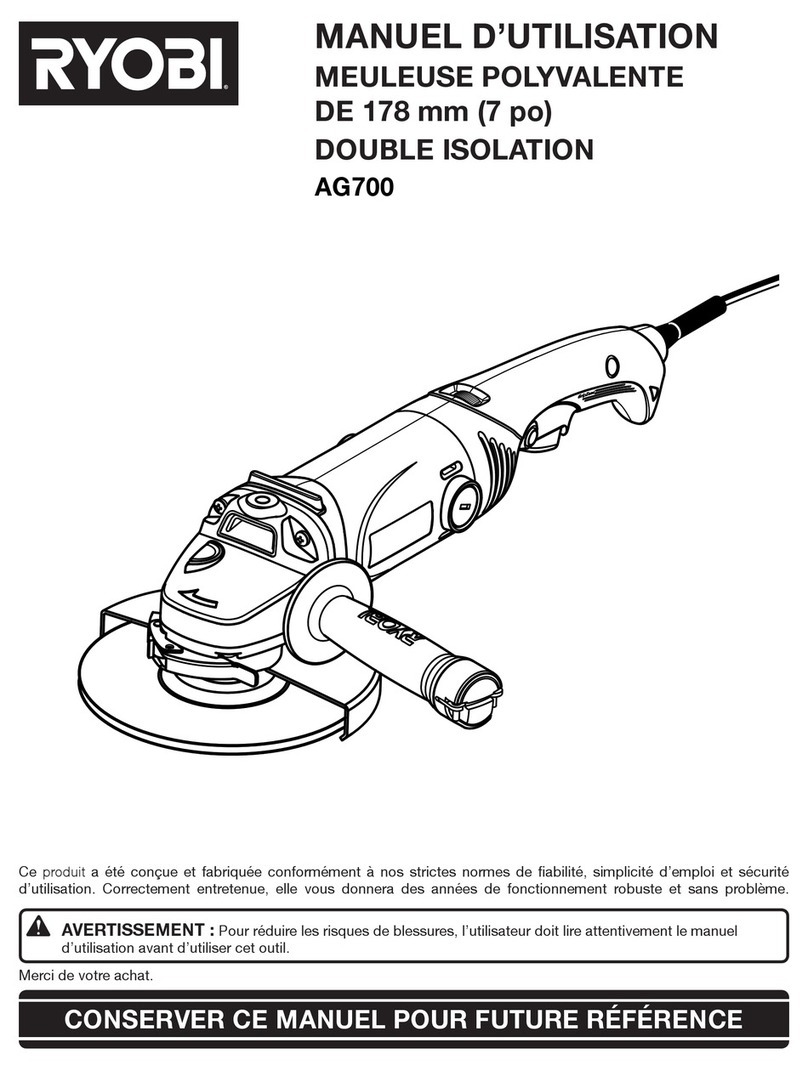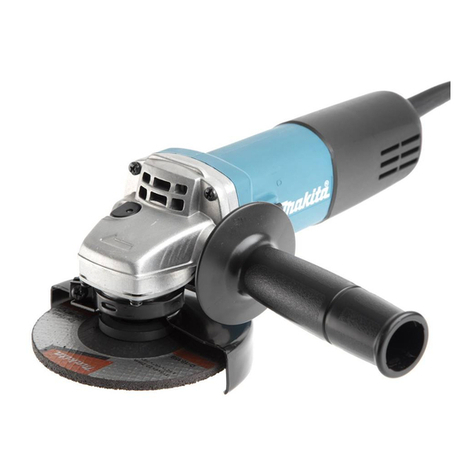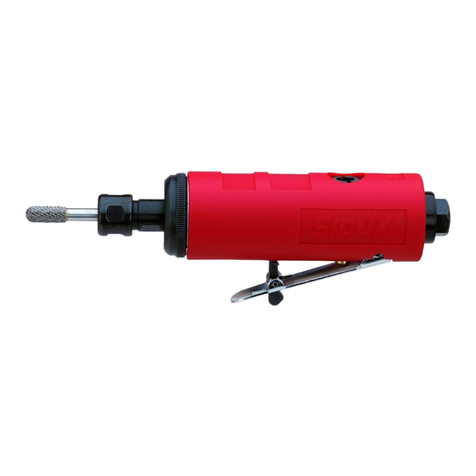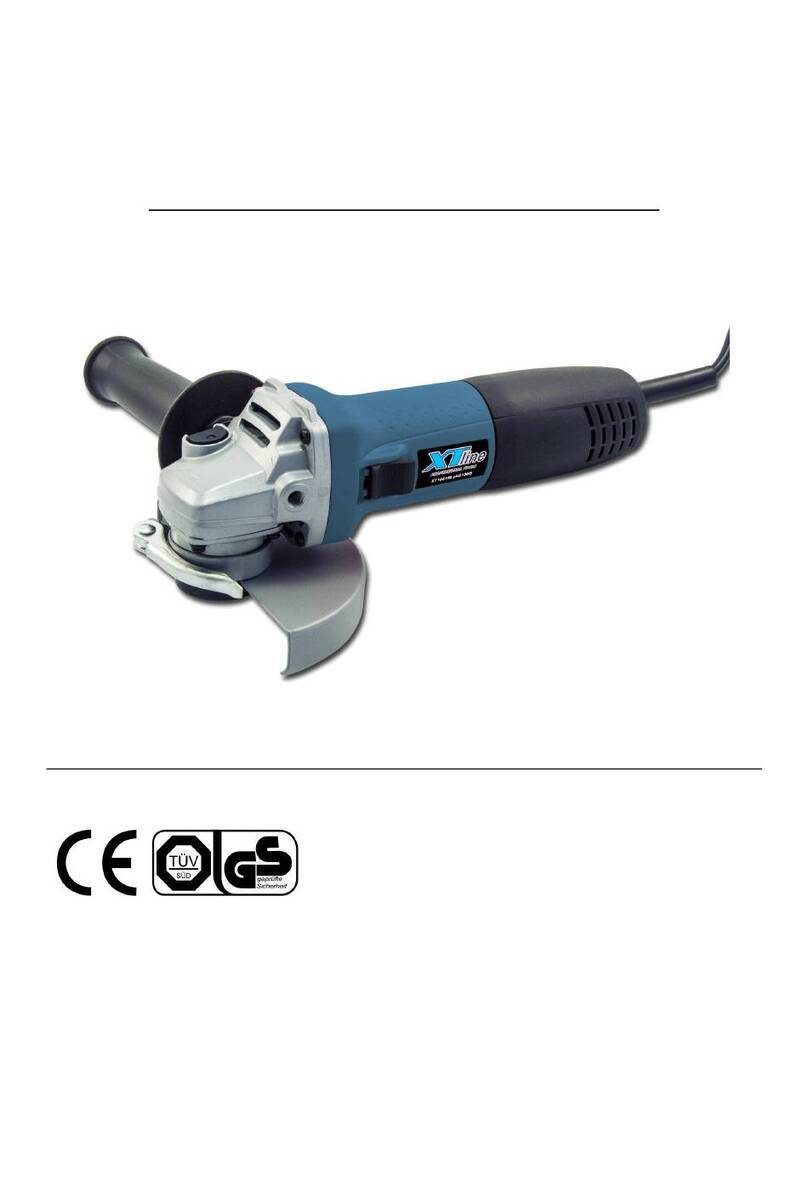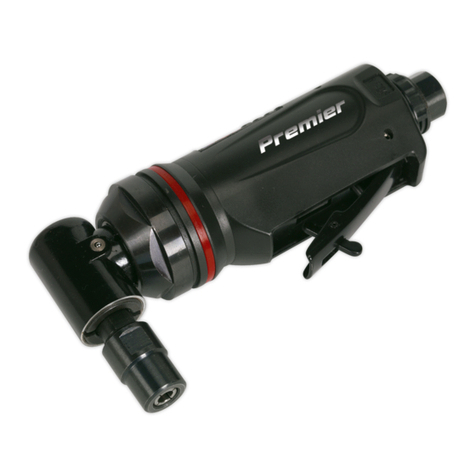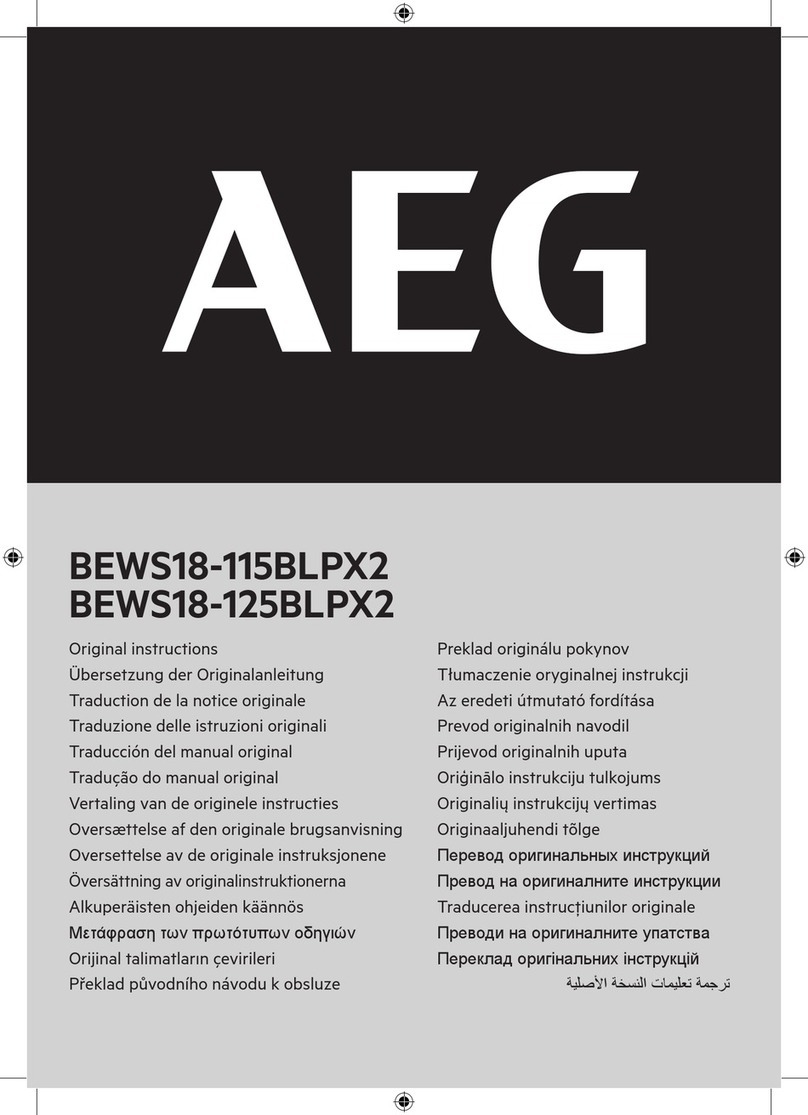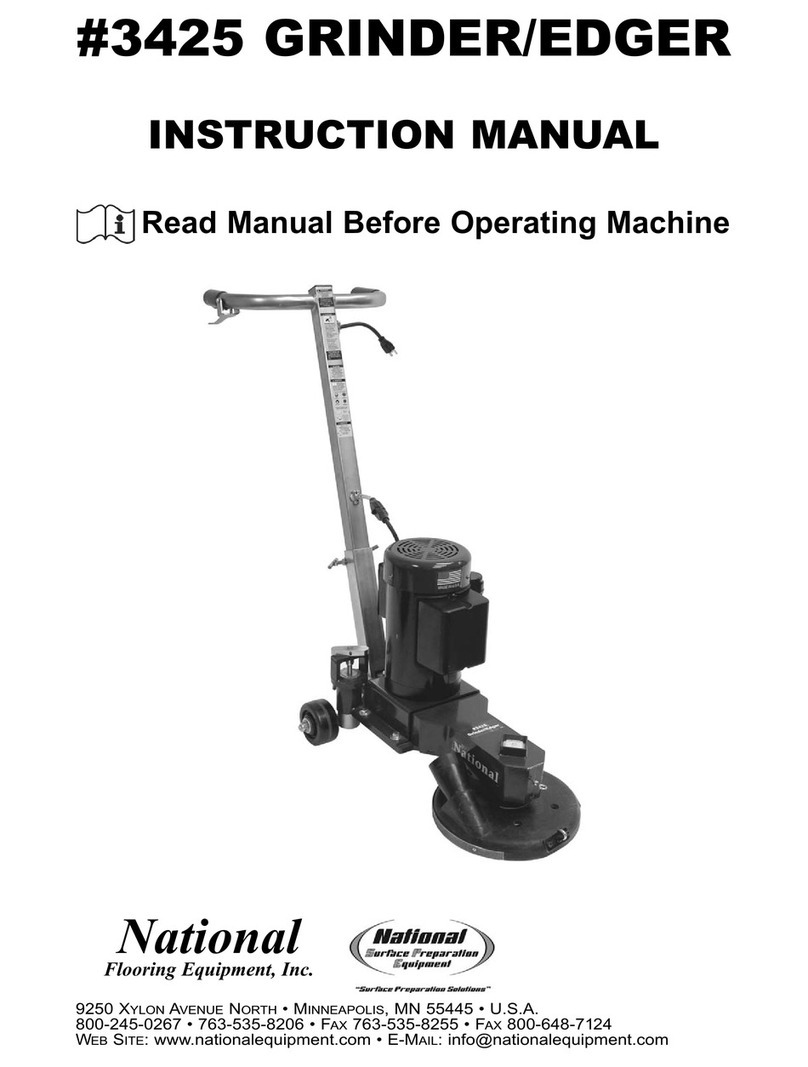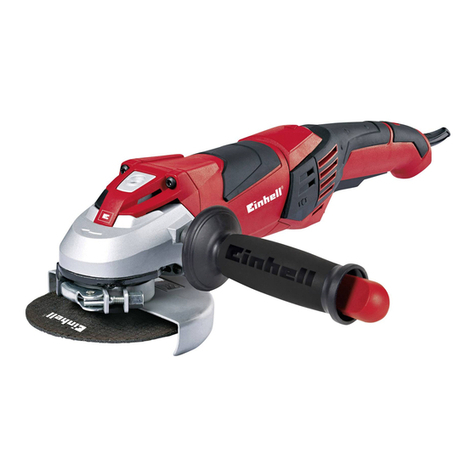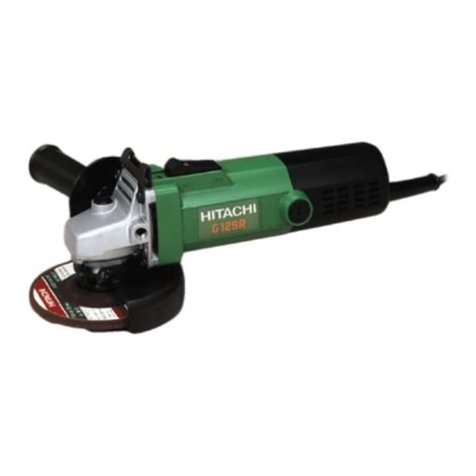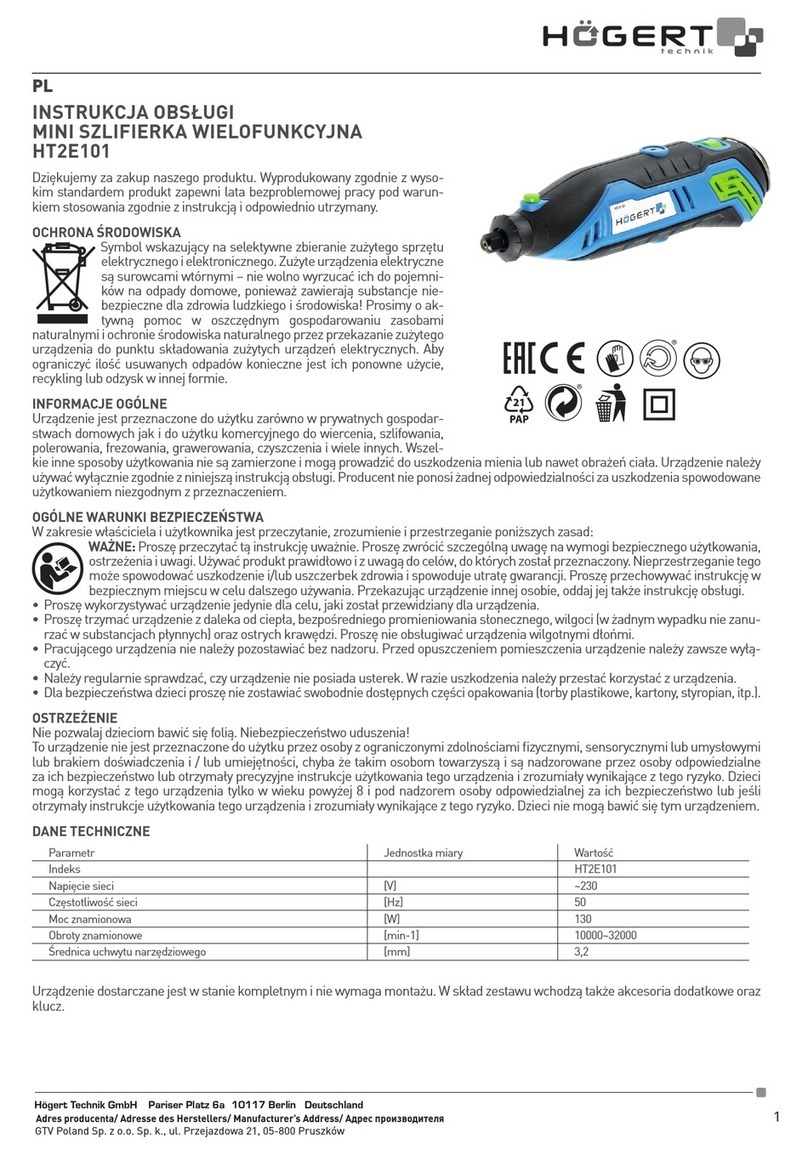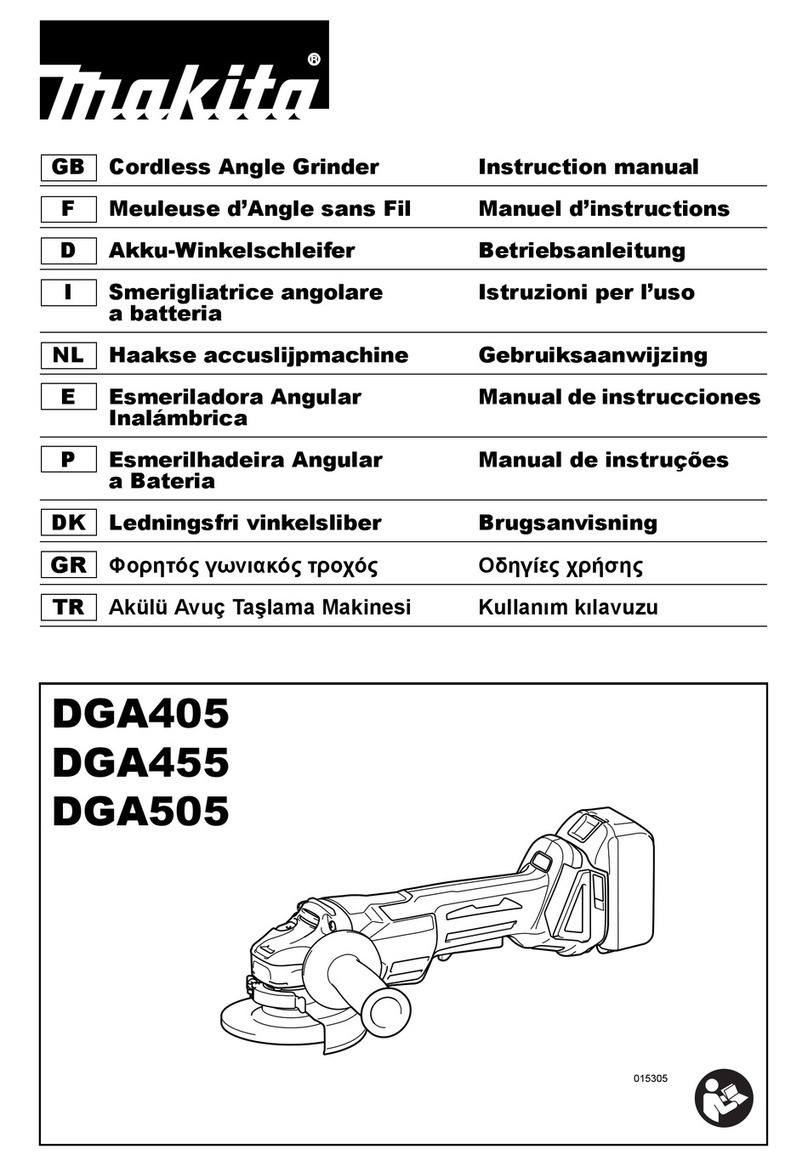Euroboor ADG.2S User manual

1
WARRANTY AND SERVICE
We (the manufacturers) warrant all products we sell to be free from defects in materials
and workmanship for a period of 360 days from the original purchase date. This warranty
does not apply to effects due directly or indirectly to abuse, misuse, negligence, normal
wear and tear down or improper maintenance, nor shall it apply to any product that has
been repaired or altered outside of our facilities. Should any product fail to provide
satisfactory service, call your distributor for return authorization but to be accompanied
with proof of purchase and an explanation for
the return.
We make no other warranty, expressed and/or implied. We shall in no event be liable for
death, injuries to persons or property, or for incidental, consequential, indirect or special
damages of any nature arising from the sale or use of the products, excepting only the cost
or expense of repair and replacement as describedabove.
This warranty gives the customer specific legal lights. Other legal rights may vary from state
to state.
WHO IS COVERED?
This warranty covers only the initial purchaser of the product.
HOW TO GET SERVICE
The product or part must be returned to the distributor or sales agent for examination. You
must provide proof of initial purchase date and an explanation of the complaint must
accompany the merchandise. If our inspection discloses a defect, we will repair or replace
the product, or refund the purchase price, at our option. We will return the repaired
product or replacement at our expense unless it is determined by us that there is no
defect, or that the defect resulted from causes not within the scope of our warranty in
which case we will, at your direction, dispose of or return the product. In the event you
choose to have the product returned, you will be responsible for the shipping and handling
costs for the return.
SAFETY INFORMATION
Please read and understand this entire manual before attempting to assemble , operate
or install the product. If you have any questions regarding the product, please contact
the distributor or sales agent.
&WARNINGS
IMPROPER OPERATION OR MAINTENANCE OF THIS PRODUCT COULD
RESULTINSERIOUS INJURY ANDPROPERTY DAMAGE. READ ANDUNDERSTAND ALL WARNINGS AND
OPERATION
INSTRUCTIONS BEFOREUSINGTHISEQUIPMENT. WHEN USING AIR TOOLS, BASIC SAFETY
PRECAUTIONS SHOULD ALWAYS BE FOLLOWED TO REDUCE THE RISK OF PERSONAL INJURY.

2
!RISKOFEYE OR HEAD INJURY
WHAT COULD HAPPEN
HOW TO PREVENT IT
•
Airpoweredequipmentandpowertoolsarecapable of
propelling materials such asfasteners, metal
chips,sawdust andotherdebrisathighspeedwhich
could result in serious eye injury.
•
AlwayswearANSIapprovedZ87.1safetyglasses with
side shields.
•Never leave operating tool unattached. Disconnect
air
hose when tool is not in use.
•
Compressed air canbehazardous. Theair system
cancauseinjurytosoft tissue areassuchaseyes, ears,
etc. Particles or objects propelled by the stream can
cause injury.
•
Foradditionalprotectionuseanapprovedfaceshield
in addition to safety glasses.
•
Toolattachments canbecomelooseorbreakandfly
apart propelling articles at the operator and others
in the work area.
•
Make sure that any attachments are securely
assembled.
!RISK OF FIRE OR EXPLOSION
WHAT COULD HAPPEN
HOW TO PREVENT IT
•
Abrasive toolssuch as sanders and grinders,
rotatingtools suchasdrills,andimpacttoolssuch as
nailers, staplers, wrenches, hammers and
reciprocating saws are capable of generating
sparks,whichcouldresultinignitionofflammable
materials.
•
Never operate tools near flammable substances
such as gasoline, naphtha, cleaning solvents, etc.
•
Work inaclean,well-ventilatedareafreeof
combustible materials.
•
Never use oxygen, carbon dioxide orother bottled
gases as a power source for air tools.
•
Exceeding themaximum pressure rating oftoolsor
accessoriescouldcauseanexplosionresultingin
serious injury.
•
Use compressed air regulated to amaximum
pressure atorbelowtheratedpressureofany
attachments.
•
Neverconnect toanairsource thatiscapable of
exceeding 200 psi.
•
Always verify prior tousing the tools that the air
sourcehasbeenadjustedtotheratedairpressure
range.
!RISK OFLOSS OF HEARING
WHAT COULD HAPPEN
HOW TO PREVENT IT
•Long term exposure to noise produced from the
operationofairtoolscanlead topermanent hearing
•
Always wear ANSI S3.19 hearingprotection.
!
INHALATION
HAZARD
WHAT COULD HAPPEN
HOW TO PREVENT IT
•
Abrasive tools,suchasgrinders,sandersandcut-off
toolsgeneratedustandabrasivematerials,which can
be harmful to human lungs and respiratory system.
•
Always wearproperly fittingfacemask orrespirator
when using such tools.
° Some materials such as adhesives and tar contain
chemicalswhosevapourscouldcauseseriousinjury
with prolonged exposure.
•
Always work in aclean, dry, well-ventilated area.

3
!
RISKOFINJURY
WHAT COULD HAPPEN
HOWTO PREVENTIT
•
Atoolleftunattended, orwiththeairhoseattached,
canbe activatedbyunauthorizedpersonsleadingto
theirinjury orinjury to others.
•
Remove airhose when toolisnotinuseandstore
toolinsecure location away fromreach ofchildren.
and untrained users.
•
Airtoolscanpropelfasteners orothermaterials
throughout the workarea.
•Use only parts, fasteners andaccessories
recommendedbythemanufacturer.
•
Keep workareacleanandfreeofclutter.Keepchildren
and
othersawayfromtool whileitisinoperation.
•
Keep work area wellIit.
•
Awrench orakeythatisleft attached to arotating
part of the tooI increases the risk of personal injury.
•
Remove adjusting keysand wrenches before turning
the tool on.
•
Using inflator nozzles fordusterapplicationscan
cause serious injury.
•
DO NOT use inflator nozzles for duster applications.
•
Air tooIs canbecomeactivatedbyaccidentduring
maintenance or tooIchanges.
•
Remove air hose to lubricate or add grinding
attachments, sandingdiscs, drills,etc.to the tool.
•
Never carry the tool by hose.
•
Avoid
unintentional
.
starting.
Don't
carry
hook-up
tool
with
finger
.
on
trigger.
•
Only an authorized servicerepresentativeshoulddo
repair servicing.
•
Air tools can cause the workpiece to move upon
contact: leading to injury.
•
Use
damps
or
other
devices
.
to
prevent
movement.
•
Lossofcontrolofthetoolcanleadtoinjury toself
or others.
•
Never use tool while using drugsoralcohol.
•
Don’t overreach.Keepproperfooting and balance.
.• Keep handles dry, clean and free from oiI/grease.
•
Stayalert.Watchwhatyouaredoing,Use common
sense.Donotoperatetoolwhenyouare tired.
•
Poorquality,improper ordamaged toolssuchas
grinding
wheels,
.
chisels
,
sockets,
drills,
nailers,
staplers,
etc., can
fly apart during operation, propelling particles
throughout the work area causing serious injury.
•
Alwaysusetool attachment ratedforthespeedof
the power tool.
•
Never use tools, which have been dropped, impacted o
r
damaged byuse.
•
Use onlyimpactgrade sockets onanImpact wrench.
•
Donotapplyexcessiveforcetothetools;letthetool
perform thework.
•
Fastenerscouldricochetorbepropelledcausing
serious
injury
or
property
.
damage:
•
Neverpointdischarge oftoolatselforothers.
•
Donotpulltriggerunlesstoolcontactsafety deviceis
against work surface.
•
Never attempttodrivefastenersintohardsurfaces
such as steel, concrete, or tile.
•
Avoiddrivinga fastenerontopofanotherfastener.
•
Positiontool carefullysothatfasteners willbe
delivered to the proper location.
•
Improperly maintained toolsandaccessories can
cause serious injury.
•
Maintain the tool withcare.
•
Keep a cutting tool sharp and clean. A properly
maintained tool, with sharp cutting edges, reduces
the
risk of binding and is easier to control.
*There is a risk: of bursting if the tool is damaged.
•
Check for misalignment or binding of moving parts,
breakage of parts and any other condition that
affects
the
tool’s
operation.
If
damaged,
have
the
tool
serviced before using.
•
Useonlyaccessories.identifiedbythemanufacturer
to be used with specific tools.
•
Useofanaccessory notintended forusewiththe
specific tools increase the risk of injury to persons.

4
!
RISK OF ELECTRIC SHOCK
WHAT COULD HAPPEN
HOW TO PREVENT IT
•
Using air tools to attach electrical wiring can result in
electrocution or death.
•
Never use nail/staplers to attachelectrical wiring
while energized.
•This tool is not provided with an insulated gripping
surface. Contact with a "live" wire will also make
exposed metal parts of the tool "live" and can result
in electrocution or death.
•
Avoid body contact with grounded surfaces such as
pipes, radiators, ranges and refrigerators. There is
an increased risk of electric shock if your body is
grounded.
•
Fasteners coming in contact with hidden electrical
wiring could cause electrocution or death.
•
Thoroughly investigate the workpiece forpossible
hidden wiring before performing work.
!
RISK OF ENTANGLEMENT
WHAT COULD HAPPEN
HOW TO PREVENT IT
•TooIs which contain moving elements, or drive other
moving parts, such as grinding wheels, sockets, sanding
discs, etc., can become entangled in hair, clothing,
jewelry andotherloose objects, resulting in severe injury.
« Neverwear loose fitting clothes orapparelthat
contains loose straps or ties, etc., which could
become entangled inmoving parts ofthetools.
•
Remove any jewelry, watches, identifications,
bracelets,necklaces, etc.,whichmightbecome
caught by the tool.
•
Keep hands away from moving parts.Tie up orcover long
hair.
•
Always wear proper fittingclothingandothersafety
equipment when using the tool.
!
RISK OF CUT OR BURNS
WHAT COULD HAPPEN
HOW TO PREVENT IT
•TooIs that cut, shear, drill, staple, punch, chisel, etc.
are capable of causing serious injury.
•
Keep theworking part of the tool away from hands
and body.
•
Replace warning labels if they become obscured orremoved.
•
Do not use this tool for other than its intended use.
•
Excessive air pressure or too much free rotation will decrease the life of the
tool and may cause a hazardous situation.
•
Check air hosefor wear,and keep themaway from heatand sharp edges. Do not
carry the tool by the air hose.
•
Slip / trip/ fall isa major causeof serious injuryor even death.Be aware of
excess hose left on your walking way or on the working surface and be aware
of the whipping air hosetoo.
•
Continuous operation and bad
working
condition
will
injure hands. Once hand
numbs oraches, operator shall stop the toolfora while
for relaxing and
re-start the
work after recovery. Operator shall immediately see a doctor if
such a serious
symptom
occurs.

5
•
Keep
visitors
a safe
distance from the work
area. keep
children
away.
•
This product may contain one or more chemicals known to
cause cancer
and birth defects or other reproductive harm. Wash hands after handling.
AIR SUPPLY
Please refer to the diagram below.
1.
Make surethat the aircompressor being usedfor the airtool operation supplies
the correct output (CFM).
2.
Have the tool in the “off” position when connecting the tool to the air supply.
3.
Use normal 90 psi (or ranging from 6.0 to 8.0 kg.) air pressure while running the tool.
High pressure and unclean air will shorten the tool’s life due to faster wear and also may
create a hazardous situation.
4.
Drain water from air compressor tank daily, as well asany condensation inthe air lines.
Water in the air line may enter the tool and damage the tool mechanisms at operation.
5.
Clean the air inlet filter cartridge weekly. The recommended hook-up procedure can be
viewed in the diagram below.
6.
Line pressure should be increased accordingly to make up for extra-long air hoses (usually
over 8meters). The minimum hose diameter should be 1/4”
I.
D. and the
fittings should have the same inside dimensions. But usually a 3/8” l.D. air hose is
recommended for air supply to get the best function of air tool operation.
7.
Use proper hoses and fittings. We do not suggest connecting quick change couplings
directly to the tool since they may ca use failure due to vibration. Instead, add a
leader hose and connect coupling between air supply and hose whip.
8.
Check hosesfor wear before individual use. Makecertain that allconnections are in
security.

SPECIFICATIONS
Item number......................................................................... ADG-2S
Capacity ................................................................................ 1/4 INCH (6 MM)
Free speed (unloaded speed) ............................................... 20,000 RPM
Average air consumption ...................................................... 5 SCFM
Working pressure ................................................................. 90 PSI (6.3 BAR)
Air inlet ................................................................................. 1/4 INCH
Air hose ................................................................................ 3/8 INCH (inside diameter)
Length x height ..................................................................... 6.81 x 2.36 INCH (173 x 68 MM)
Weight .................................................................................. 0.39 KGS (0.86 LBS)
PACKAGING CONTENTS
PREPARATION
Figure 1
Before beginning assembly or operation of the product, make sure that all parts are
present. Compare the parts with the package contents list. If any part is missing or
damaged, do not attempt to assemble, install or operate the product. Contact the
distributor or sales agent for replacement.
OPERATING INSTRUCTIONS
1.
Lubricate thetool before operating. See “CARE AND
MAINTENANCE” section for oilinginstructions.
2.
Loosen the collet fixing cap (Part #31) counterclockwise with
one wrench while holding the other wrench on the flats of
the collet base (Part #27). (See Figure 1)
3.
Insert a grinding accessory like a grinding stone (not
provided) into the collet hole. (See Figure 2)
4.
Tighten the collet fixing cap clockwise with one wrench while
holding the other wrench on the flats of the collet base. Make
sure the collet fixing cap is securely tightened. (See Figure 3)
!
Only use grinding accessories that
have an RPM
rating equal to or greater than the
tool itself.
Figure 2
Figure 3
Description
Quantity
1/4" (6 mm) Mini Air Die Grinder
1
Wrench
2
Male Plug
1
Manual
1

7
5.
Remove the air cap from the tool air inlet and connect the air
supply hose to the tool. Set the air pressure at 90 PSI.(See Figure
4)
6.
Push forward the lever block (Part #4)and press down on the
lever trigger (Part #3). How far the lever trigger is pressed
determines the tool rotation speed. Then the tool starts to
work. (See Figure 5)
CARE AND MAINYENANCE
The tool shouldbe lubricated daily(or before eachuse) with air
tool oil (not included).
Air tool oil is available at major tool hardware stores. SAE
#10 weightoil or sewingmachine lubricant orany other
high grade turbine oil containing moisture absorbent,
rust inhibitors, metal wetting agents and an EP (extreme
pressure) additive may be used as a substitute. Do not
use detergent oil.
During continuous operation, the tool should be oiled
every 1 to 2 hours. This may be done using an in-line oiler,
or manually. If done manually, proceed as follows:
1.
Disconnect the tool from air supply. (See Figure 6)
2.
Place a few drops of air tool oil into the air inlet.
(See Figure 7)
Avoid the misuse of thicker oil which may lead to the reduced
performance or malfunction.
3.
Connect thetool to theair supply. Run thetool without load for
a fewseconds to distribute the oil through the tool.
Any excess oilmay be propelledfrom the exhaustarea. So
keep the tool away in a safedirection.
4.
After operating the tool and before storing the tool,
disconnect the airhose and place4 or 5drops of airtool oil into
the air inlet, then re-connect the air hose and run the tool to
evenly distribute the oil throughout the tool for 30 seconds
approximately. This will prolong thetool life.
5.
Avoid storing the tool in a humid environment which
promotes rusting of internal mechanisms. Always oil the tool
before storage.
6.
When thetool is seriously damaged or outof life, itshould be
left ina resource recyclingcan. Never dropit into fire.
Figure 4
Figure 5
Figure 6
Figure 7

8
TROUBLESHOOTING
Problem
Possible Cause
Corrective Action
Tool runs slowly
or will not
operate
1.
Grit orgum in tool.
2.
No oil in tool.
3.
Low airpressure.
4.
Air hose leaks.
5.
Pressure drops.
6.
Worn rotor blade.
7.
Moisture blowing out
of tool exhaust.
1.
Flush the tool with air-tool oil or gumsolvent.
2.
Lubricate the tool according to the lubrication
instructions in this manual.
3.
a. Adjust the regulator on the toolto maximum
setting.
b. Adjust the compressor regulator to tool
maximum of 90 PSIG.
4.
Tighten and seal hose fittings if leaks are found. Use
sealing tape.
5.
a. Besure the hose is the proper size. Long hose or
tools using large volumes of air may require ahose
with an
1.
D. of 1/2in. or largerdepending on the total
length of the hoses.
b. Do not use a multiple number of hoses
connec
ted together with quick-connect fittings.
This
causes additional pressure drops and reduces
the tool power. Directly connect the hoses
together.
6.
Replace rotor blade.
7.
Water in tank: drain tank. (See air compressor
manual). Oil tool and run until no water is evident. Oil
tool again and run 1-2 seconds.
Abnormal
vibration and/or
excessive heat
develops in
the tool.
Improper lubrication.
Follow proper lubrication procedures in this manual.
For any special troubles which cannot be settled down by the operator, contact the
distributor or sales agent from whom you purchase the tool.

9
EXPLODED DIAGRAM AND PARTS LIST

10
•
Contact the distributor or sales agent from whom you purchase the tool for spare parts
ordering for any necessary replacement to get continuous use of tool and for extending
the toollife.
•
When ordering spare parts and components, give each part number and order
quantity.
Thank you.
Discover other pneumatic grinders on our website.
Table of contents
Other Euroboor Grinder manuals

Euroboor
Euroboor EDG.600 User manual

Euroboor
Euroboor AGR.2200/180 User manual

Euroboor
Euroboor ADG.2E User manual

Euroboor
Euroboor AGR.1200 User manual

Euroboor
Euroboor EDG.600 User manual

Euroboor
Euroboor ADG.2A User manual

Euroboor
Euroboor AGR.840 User manual

Euroboor
Euroboor AGR.1400 User manual
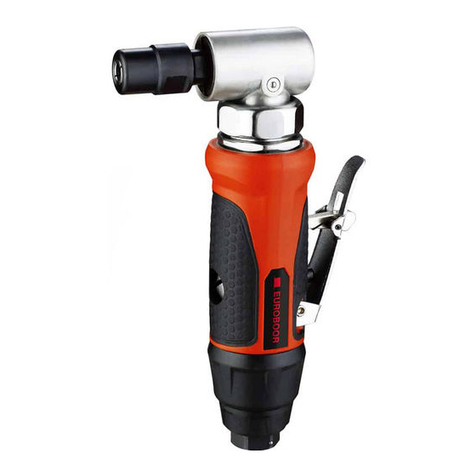
Euroboor
Euroboor ADG.2A User manual
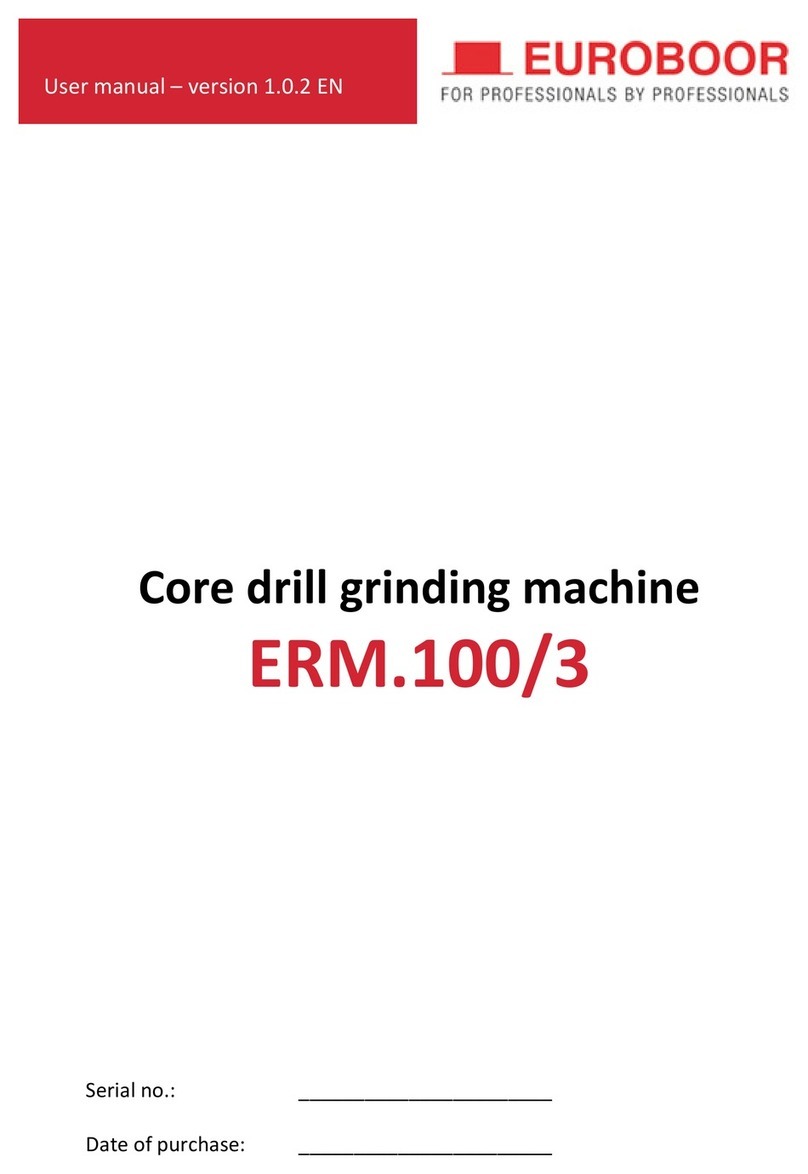
Euroboor
Euroboor ERM.100/3 User manual




